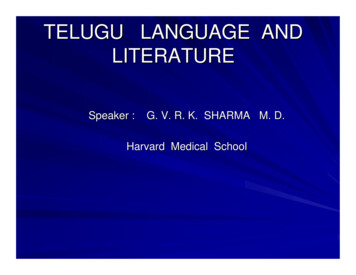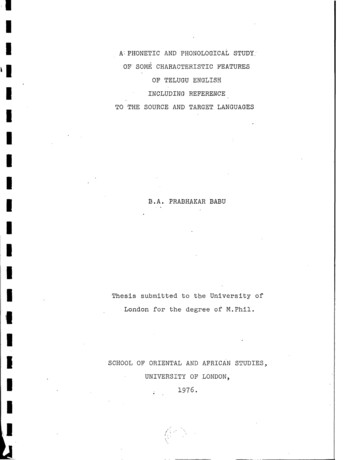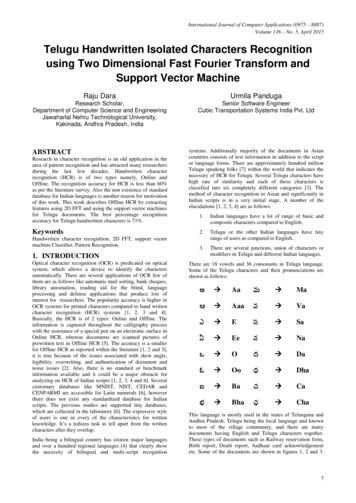
Transcription
International Journal of Computer Applications (0975 – 8887)Volume 116 – No. 5, April 2015Telugu Handwritten Isolated Characters Recognitionusing Two Dimensional Fast Fourier Transform andSupport Vector MachineRaju DaraUrmila PandugaResearch Scholar,Department of Computer Science and EngineeringJawaharlal Nehru Technological University,Kakinada, Andhra Pradesh, IndiaSenior Software EngineerCubic Transportation Systems India Pvt. LtdABSTRACTResearch in character recognition is an old application in thearea of pattern recognition and has attracted many researchersduring the last few decades. Handwritten characterrecognition (HCR) is of two types namely, Online andOffline. The recognition accuracy for HCR is less than 60%as per the literature survey. Also the non existence of standarddatabase for Indian languages is another reason for motivationof this work. This work describes Offline HCR by extractingfeatures using 2D FFT and using the support vector machinesfor Telugu documents. The best percentage recognitionaccuracy for Telugu handwritten characters is 71%.KeywordsHandwritten character recognition, 2D FFT, support vectormachine Classifier, Pattern Recognition.systems. Additionally majority of the documents in Asiancountries consists of text information in addition to the scriptor language forms. There are approximately hundred millionTelugu speaking folks [7] within the world that indicates thenecessity of HCR for Telugu. Several Telugu characters havehigh rate of similarity and each of these characters isclassified into six completely different categories [3]. Themethod of character recognition in Asian and significantly inIndian scripts is in a very initial stage. A number of theelucidations [1, 2, 3, 4] are as follows:1.Indian languages have a lot of range of basic andcomposite characters compared to English.2.Telugu or the other Indian languages have tinyrange of users as compared to English.3.There are several junctions, union of characters ormodifiers in Telugu and different Indian languages.1. INTRODUCTIONOptical character recognition (OCR) is predicated on opticalsystem, which allows a device to identify the charactersautomatically. There are several applications of OCR few ofthem are as follows like automatic mail sorting, bank cheques,library automation, reading aid for the blind, languageprocessing and defense applications that produce lots ofinterest for researchers. The popularity accuracy is higher inOCR systems for printed characters compared to hand writtencharacter recognition (HCR) systems [1, 2, 3 and 4].Basically, the HCR is of 2 types: Online and Offline. Theinformation is captured throughout the calligraphy processwith the assistance of a special pen on an electronic surface inOnline HCR, whereas documents are scanned pictures ofprewritten text in Offline HCR [5]. The accuracy is a smallerfor Offline HCR as reported within the literature [1, 2 and 3],it is true because of the issues associated with skew angle,legibility, overwriting, and authentication of document andnoise issues [2]. Also, there is no standard or benchmarkinformation available and it could be a major obstacle foranalyzing on HCR of Indian scripts [1, 2, 3, 4 and 6]. Severalcustomary databases like MNIST, NIST, CEDAR andCENPARMI are accessible for Latin numerals [6], howeverthere does not exist any standardized database for Indianscripts. The previous studies are supported tiny databases,which are collected in the laboratory [6]. The expressive styleof users is one in every of the characteristics for writtenknowledge. It’s a tedious task to tell apart from the writtencharacters after they overlap.India being a bilingual country has sixteen major languagesand over a hundred regional languages [4] that clearly showthe necessity of bilingual and multi-script recognitionThere are 18 vowels and 36 consonants in Telugu language.Some of the Telugu characters and their pronunciations areshown as follows:అ Aaమ Maఆ Aaaవ Vaఎ Eస Saఏ Eeన Naఒ Oద Daఓ Ooధ Dhaబ Baచ Caభ Bhaఛ ChaThis language is mostly used in the states of Telangana andAndhra Pradesh. Telugu being the local language and knownto most of the village community, and there are manydocuments having English and Telugu characters together.These types of documents such as Railway reservation form,Birth report, Death report, Aadhaar card acknowledgementetc. Some of the documents are shown in figures 1, 2 and 3.7
International Journal of Computer Applications (0975 – 8887)Volume 116 – No. 5, April 2015Figure-1 shows news regarding two magistrates delivered averdict in Telugu. Lord Hanuman Prayer is shown in Teluguin figure-2.Fig 2: Lord Hanuman Prayer in TeluguThis paper describes the process of recognizing the isolatedbasic characters in a document. Section II describes existingmethods for Handwritten Character Recognition systems. Thestep by step algorithm is described in section III. In section IVthe experimental results are shown. Section V reports the finalconclusions.2. BACK GROUND WORK FORHANDWRITTEN CHARACTERRECOGNITION SYSTEMSFig 1: Two magistrates deliver verdict in TeluguManjunath Aradhya and Hemanth Kumar [4] worked forEnglish handwritten documents based on Fourier transformfollowed by PCA for 75 training samples or character classes,and reported the recognition accuracy as 79.6% for FourierPCA (F-PCA) whereas the recognition accuracy for PCA isreported as 76.6%. When the number of training samples wasincreased to 175 classes, the recognition accuracy wasreported as 93.8% and 90.8% for F-PCA and PCArespectively. The bilingual recognizer for printed documentsconsists of Hindi and Telugu is presented by Jawahar et al [8],which is based on principal component analysis (PCA)followed by support vector classification (SVC), anddetermined Hindi characters provide good recognition even ata resolution of 15x15, whereas Telugu characters need moredetails with 40x40, finally reported the overall accuracy of96.7%. Using cross correlation coefficient concept, the offlineHCR for the Gujarati script is presented by Prasad et al [9], inthis work, the shape of the character is analyzed and thefeatures are compared to identify character and the overallefficiency of the system is found to be 71.66%. Sutha andRamaraj [10] worked on Tamil HCR, Fourier descriptors areused as feature vectors for identifying a character,implemented multilayer perceptron with a hidden layer innetworks and reported recognition accuracy of 97%. Slantcorrection is improved using octal graph and independent ofthe writing style the basic form of a character is representedusing the graph [11] and the recognition accuracy is found tobe 82%. Ramakrishnan et al [12] worked on a specific font inEnglish based on Zernike moments and Delaunaytriangulation, Support Vector Machine Classifier is used for8
International Journal of Computer Applications (0975 – 8887)Volume 116 – No. 5, April 2015classification, and the accuracy is found to be 85.85% forwords. When the written text had a signature, then thereported accuracy is 92.22%. Pujari A.K. et al [13] worked forTelugu HCR using wavelet multi resolution analysis andassociative memory, Hope field-based Dynamic neuralnetwork is used for learning the style and font from thedocument, and tested the same text for different fonts and theefficiency ranged from 85% to 92.1%. Bunke et al [14]worked on offline cursive HCR system using Hidden MarkovModel; the words are recognized by extracting the edges inthe order of skeleton graph of the word, in this work 9000words for training and 3000 words for testing are used andreported the accuracy to be 98%. Hanmandlu et al [15]proposed a method for language independent HCR systemusing neural networks and fuzzy logic, the vector distancebetween each point and a fixed point is used as a featurevector and reported a recognition accuracy of 97% to 98% forneural network and fuzzy logic respectively.3. METHODOLOGYThere is no any common obtainable place for databases forIndian languages and hence it becomes terribly troublesomefor the event of hand written character, thus the databases aredeveloped by the researchers within the laboratories for handwritten character recognition [6]. There are eighteen vowelsand thirty six consonants in Telugu.else increment the couple count.11. Show the take a look at image and also the matchedinfo image.3.3 Mathematical model of 2-D FFTTwo dimensional Fourier transforms involves a number ofone dimensional Fourier transforms. From the definition of2D FFT equation (1) shows the 2D FFT of the image f (p, q)and equation (2) represents inverse 2D FFT. The 2D FFT F (s,t) for the image f (p, q) can be found using formula𝐹 𝑠, 𝑡 𝑀1𝑀𝑁𝑝 0Nq 0 fsptqp, q e j2π( M N ) (1)Whereas, s 0, 1, 2 .M, & t 0, 1, 2 .N.Here p, q are the pixel coordinates in the image and s, t arecoordinates in the "transformed image".The inverse 2D FFT (from FFT back to the original image,possibly after filtering) can be obtained using below givenformula𝑀𝑓 𝑝, 𝑞 𝑠 0Nt 0 Fsptqs, t ej2π( M N )(2)Where p 0, 1, 2 .M, & q 0, 1, 2 .N.3.1 Dataset DetailsThese formulas assume calculations using complex numbersIn this article, the amount of categories or charactersinformation developed is 100. Every character is written on apaper in an exceedingly rectangular manner in completelydifferent sizes and designs by 50 individual writers. Thewritten documents were then inheritable by scanning by aflatbed scanner. These pictures are preprocessed to theminimum boundary parallelogram conception; social controlis performed to a size of 100x100. Thus a complete variety of1500,750 samples were developed for coaching whereas 750samples were developed for testing purpose. To increase theamount of databases, every image is resolved by 30, -30, 50and -50 and keeps the feature in coaching sample set. By thisthe amount of the information is raised to 5 times.(3.2 Algorithmic Rule for Implementing2-D FFTThe following is the step by step algorithmic rule for 2-D FFT,enforced on basic and isolated written characters.1.Load the pictures of size of 100x100 pixels.2.Scan all the pictures.3.Binarize the pictures employing a threshold of 0.854.Rotate the pictures by -3, 3, -5 and 5 degrees toget artificial information.5.Notice the 2-D FFT for all the first and syntheticallygenerated pictures.6.Reshape the matrix into column matrix to make thefeature vector for every image.7.Repeat the higher procedure to take a look at picturesadditionally.8.Notice the space between the column matrices andtake a look at image and every training image.9.Notice the minimum distance.).4. RESULTS AND DISCUSSIONSThe image of a document is scanned and saved in thecomputer which is used as an input image for the recognizer.The scanner used is 600 dpi using WIA Cano scan LiDE 100flatbed scanner. The images are preprocessed first usingAdobe Photoshop. Further they are preprocessed usingMATLAB tools and the synthetic data is generated, then the2-D FFT is applied to all the images. Finally, the Euclideandistance is measured between each test image and thedatabase images. It is found that the database image has thelowest Euclidean distance to the test image. The test image isdisplayed on the left side, whereas the matched image of thedatabase is shown on the right side.The total number of isolated character set of Telugu databaseconsists of 4,250 samples. Out of 4,250 samples 3,750samples are used for training and 500 samples are used fortesting. Further the size of the database is increased byrotation as described earlier, thus the available size of thedatabase is 18,750 samples (375samples or classes). Thesystem is trained by varying the training sample number by75, 150, 225, 300 and 375. Table I shows the recognitionaccuracy by varying the number of training samples orclasses.All the Telugu characters can be divided into 6 groups, eachcharacter within the group has high similarity measure withany other character in the same group [3]. A few matched andmismatched samples of Telugu database are shown in thefigure- 4 and figure-5 respectively. In every set, the test imageis displaced first and then its matched database image. Fromfigure-5 it is very clear that due to more number of similarcharacters in Telugu script there is a lot of confusion betweentwo characters of the same group [3]. Hence the recognitionaccuracy drastically decreases.10. Increments the match counts if category matches or9
International Journal of Computer Applications (0975 – 8887)Volume 116 – No. 5, April 2015Table 2. Comparison of 2D FFT resultsDescriptionPublishedMethod [4]Proposed rtransformfollowed byPCATwo DimensionalFast FourierTransformNumber oftrainingsamples orclasses75375(75 original data 300 synthetic data)MediumWritten on paperWritten on paperRecognitionAccuracy85%71%Fig 3: Characters matched correctly5. CONCLUSIONHandwritten character recognition for Telugu characters isexplored during this work. A complete variety of 1500, 750samples used for training and 750 samples for testing area isdeveloped and additionally normalized to 100x100 pixels. Thepopularity accuracy obtained by exploitation of 2D FFT is71%.6. REFERENCESFig 4: Mismatched charactersTable 1. Table captions should be placed above the tableNumber of TrainingSample ClassesRecognition Accuracy(%)753215056225593006137563In table 2, the 2D FFT results are compared with thepublished method. Aradhya and Hemanth Kumar [4]experimented on English characters by extracting the featuresusing Fourier transform followed by PCA and Support VectorMachine for classification. The recognition accuracy wasreported as 85% for 100 training samples or classes. In thispaper, the features are extracted using 2-D FFT and SupportVector Machine, and the recognition accuracy is 71% eventhough the proposed method uses a single stage for featureextraction.[1] P. N. Sastry and R. Krishnan. “Isolated Telugu palm leafCharacter recognition using radon transforms–a novelapproach”. In IEEE-WICT, 2012.[2] P. N. Sastry, R. Krishnan and T.V. Rajinikanth. Palmleaf Telugu character recognition using Houghtransform. In Proceedings of International Conferenceon Advanced Computing Methodologies (ICACM-2011),pages 21–28, Dec 2011 Elsevier.[3] P. N. Sastry, R. Krishnan and B. V. Sanker Ram. Telugucharacter recognition on palm leaves-a three dimensionalapproach technology. Spectrum (JNTU Hyderabad),2(3):19–26, Nov. 2008.[4] S.V.N.Manjunath Aradhya and G.Hemanth Kumar.Multilingual OCR system for south Indian scripts andEnglish documents. In 5th IFIP International Conferenceon Intelligent Information Processing, pages 658–668,2008 Elsevier.[5] Munish Kumar, R.K.Sharma and M.K.Jindal. OfflineHandwritten Gurumukhi Character Recognition: Studyof Different Feature-Classifier Combinations. In theproceedings of the Workshop on Document Analysis andRecognition, Dec 2012.[6] U. Bhattacharya and B.B. Chaudhuri. Handwrittennumeral databases of Indian scripts and multistagerecognition of mixed numerals. IEEE transactions onpattern analysis and machine intelligence, 31(3):444–457, Mar. 2009[7] P. N. Sastry, R. Krishnan and B. V. Sanker Ram.Classification and identification of Telugu handwrittencharacters extracted from palm leaves using decision treeapproach. ARPN Journal of Engineering and Applied10
International Journal of Computer Applications (0975 – 8887)Volume 116 – No. 5, April 2015Sciences, 5(3), Mar. 2010.[8] Jawahar, C.V., Pavan Kumar, M.N.S.S.K., Ravi Kiran,S.S., 2003.A bilingual OCR for Hindi-Telugudocuments and its applications. In proceedings ofICDAR, 3-6 August, Edinburgh, pp 656-660.[9] Prasad J.R., Kulkarni U.V., Prasad R.S., “Offlinehandwritten character recognition of Gujarati script usingpattern matching”. ASID (Anti-counterfeiting, Securityand Identification in Communication) 2009 pp.611-615.[10] Sutha, J. and Ramaraj N., “Neural Network BasedOffline Tamil handwritten character recognition system”.International conference on computational Intelligenceand Multimedia Applications”, 2007, vol.2, pp.446-550.[11] R. Jagadeesh Kannan and R. Prabhakar, “An improvedHandwritten Tamil Character Recognition System usingOctal Graph”, Journal of computer science, vol.4, No.7,2008, pp.509-516.[12] KandanRamakrishnan,ArvindK.R.andA.G.Ramakrishnan, “Localization of handwritten text indocuments using moment invariants and computational Intelligence and Multimedia Applications,vol.3 2007, pp.408-414.and B.C.Jinaga, “An intelligent character recognizer forTelugu scripts using multiresolution analysis andassociative memory”, Image and vision computing,vol.22. 2004, pp.1221-1227.[14] H.Bunke, M.Roth and E.G.Schukat-Talamazzini,“Offline Cursive Handwriting Recognition using HiddenMarkov Models”, Pattern Recognition, Vol.28, No.9,1995, pp. 1339-1413.7. AUTHORS’ PROFILERaju Dara is a Research Scholar of Department of ComputerScience and Engineering, Jawaharlal Nehru TechnologicalUniversity, Kakinada. He has 12 years of teachingexperiences for Graduate and Post Graduate engineeringcourses. His current research interests are Data Warehousing,Image Processing. He published 5 research papers ininternational journals and 3 research papers in internationalconferences.Urmila Panduga is working as a senior software engineer forthe past 8 years with various software industries and workedas an Assistant Professor for 2 years in an Engineeringcollege, her areas of interest are Image Processing, Databases,and System Programming. She published 2 research papers ininternational journals and 1 research paper in internationalconference[13] Arun K. Pujari, C. Dhanunjaya Naidu, M.Sreenivasa RaoIJCATM : www.ijcaonline.org11
3.3 Mathematical model of 2-D FFT Two dimensional Fourier transforms involves a number of one dimensional Fourier transforms. From the definition of 2D FFT equation (1) shows the 2D FFT of the image f (p, q) and equation (2) represents inverse 2D FFT. The 2D FFT F (s, t)

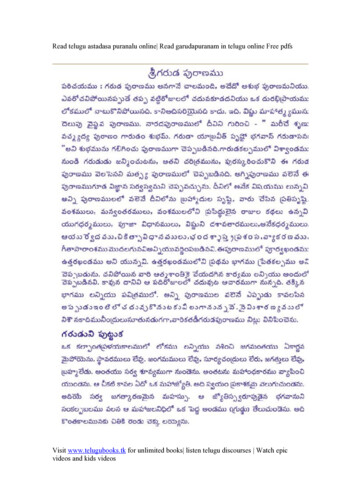
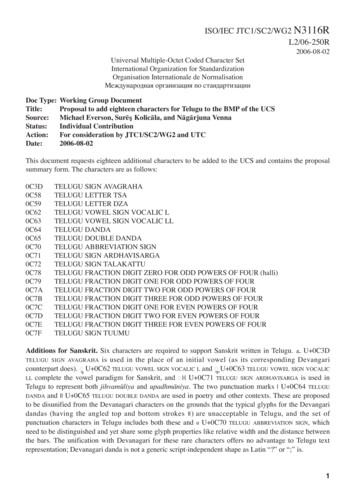
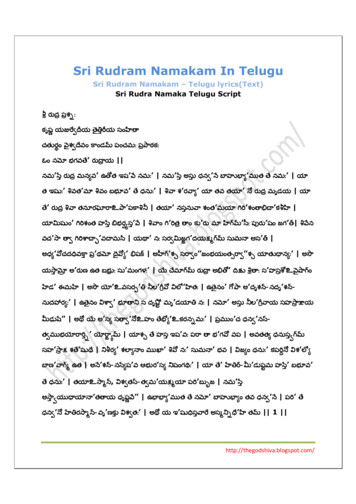
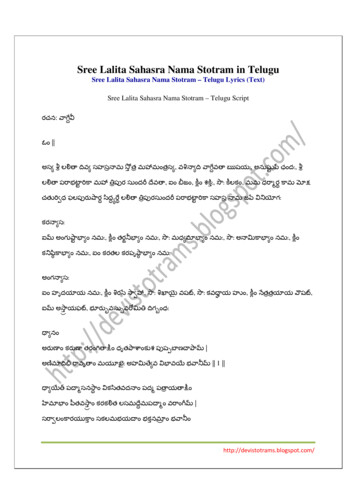
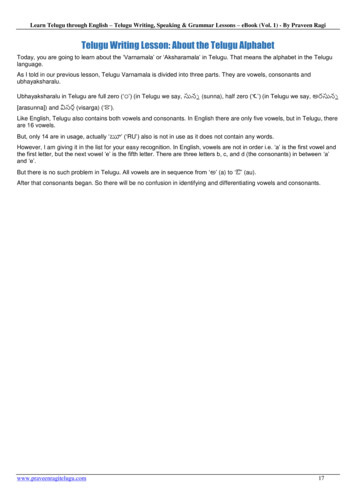
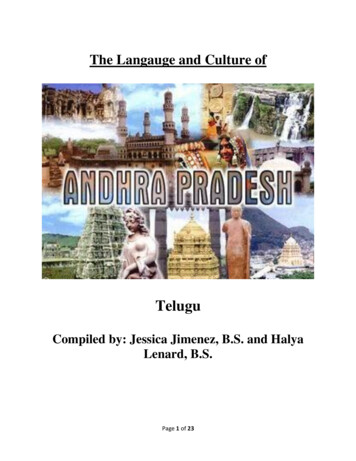
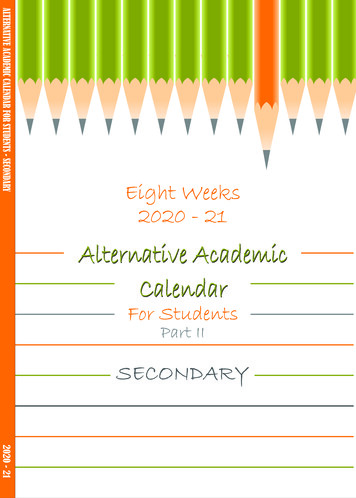
![Untitled-3 [mainetelugu ]](/img/4/telugu-alphabet-workbook.jpg)
